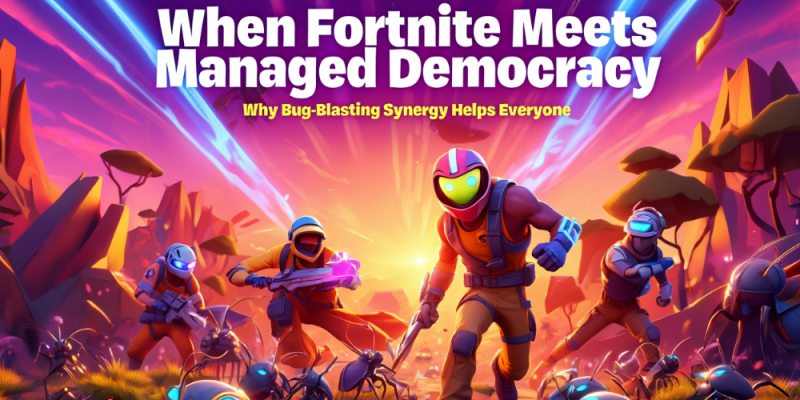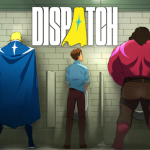When Fortnite Meets Managed Democracy: Why Bug-Blasting Synergy Helps Everyone

Tell me you didn’t feel a jolt of recognition the first time you saw Fortnite’s newest insectoid hordes sprinting across the map. The swarming silhouettes, the acid arcs, the frantic scramble to hold a perimeter—there’s a familiar energy that unmistakably echoes Helldivers 2’s bug-clearing operations. And honestly, that’s perfectly fine. Live-service games are cultural conversations as much as they’re products; ideas bounce, mutate, and return in fresh forms. Fortnite remains the genre’s gravitational center, constantly remixing pop culture and mechanics at a scale no one else can match. Arrowhead, meanwhile, has carved a clear identity with cooperative chaos, tongue-in-cheek militarism, and hard-earned triumphs against overwhelming odds. The point isn’t who planted the first flag on a mound of chitin—it’s that players get more of what we love, in different flavors. If anything, Epic’s spin broadens the audience for insect-slaying PvE while giving Helldivers 2 renewed oxygen, because curiosity travels fast when millions are paying attention.
Main Part
The lineage here is older than both games: Starship Troopers set the tone, Earth Defense Force popularized city-level swarms, and countless sci-fi universes taught us why insectoid factions work so well. They communicate threat at a glance, they scale from skirmishes to apocalyptic tides, and they generate great tactical questions: control the chokepoints or kite the mass? Fortnite adapts that grammar through its own toolkit—mobility-first gunplay, vibrant readability, and a cooperative vibe that rewards quick improvisation. Throw in gadgets, traversal items, and snappy revive loops, and you get a version of bug-busting that prizes momentum as much as marksmanship. Helldivers 2, by contrast, leans on high-stakes coordination, friendly fire tension, and meta-progression grounded in stratagem mastery. Both answer the same fantasy—planetfall, pressure, and triumph—yet they express it differently. That difference is precisely why they can coexist, cross-pollinate, and even propel each other when the zeitgeist latches onto a theme.
Community discourse inevitably circles the line between homage and copycat, but the law and the craft operate on broader principles. You can’t own “space bugs” any more than you can own “pirates” or “zombies”; what you can own is tonal nuance, sharpening arcs, and the systems that produce signature moments. Arrowhead’s sardonic doctrine, evac cliffhangers, and stratagem decision trees feel singular. Epic’s strengths are cadence, accessibility, and the sheer spectacle of scaling an idea to a hundred million players in a weekend. That doesn’t diminish Arrowhead; if anything, it spotlights the subgenre and sends curious players outward. We’ve already seen UEFN creators riff on extraction loops, defensive holds, and objective-driven drops—the hobbyist layer becomes a lab where ideas bounce back into the mainstream. This is how modern design evolves: fast, public, iterative. Instead of tribal gatekeeping, we’re watching a rising tide that can lift everyone who ships with confidence and a distinct voice.
If you’re planning to dive into Fortnite’s bug content, treat it like a moving puzzle. Loadouts built around area denial and stagger shine: explosive ordnance for crowd thinning, flame effects for denial zones, and fast-firing primaries to clean up after the splash. Run mobility tools to break encirclements—grapples, slides, and boosts keep you from getting boxed in. Establish a firing arc before the swarm crests, then rotate your focus by role: one player on add control, one on elite interrupters, one on objective upkeep, one floating for pickups and stun tools. Target weak spots and status carriers first; denying acid or webbing pays defensive dividends. Communicate cooldowns plainly, ping burrow points, and keep a mental map of escape lanes. On the settings side, raise audio priority for creature cues, lower post-processing for clearer silhouettes, and tune sensitivity for snap-target switching. The goal is simple: flow state under pressure, with squads acting like a single organism.
Conclusion
So where does this leave Arrowhead and Epic? In a healthier ecosystem than people assume. Epic reaffirms why it’s the live-service incumbent: unmatched delivery, mainstream reach, and a talent for reframing trends without losing approachability. Arrowhead proves that a focused identity can cut through the noise, turning satire, camaraderie, and deliberate friction into unforgettable nights with friends. Put together, the moment feels less like a turf dispute and more like a shared victory for cooperative PvE. Players get variety, creators get a bigger stage, and the industry gets permission to iterate in public. If we’re lucky, the cross-traffic even nudges future collabs—cosmetics, island takeovers, or limited-time directives that let these styles nod to each other without compromise. For now, enjoy the surge: hop into Fortnite for the spectacle, drop into Helldivers 2 for the grit, and let your mood decide the flavor of bug-busting you want tonight.
















